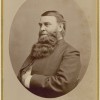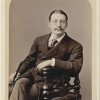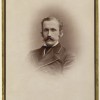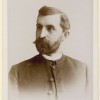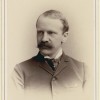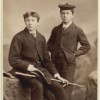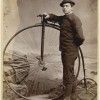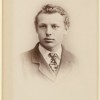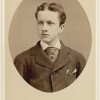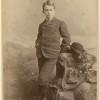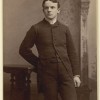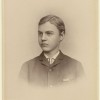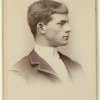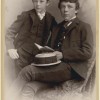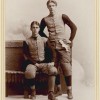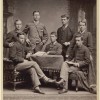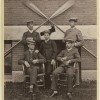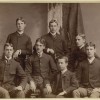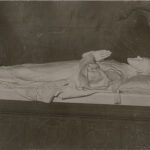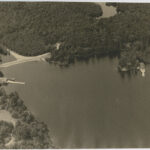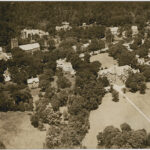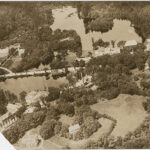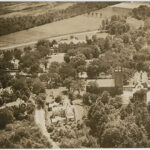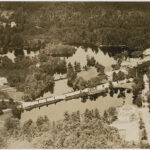Formmates and Friends: The Early Cabinet Card Portraits of St. Paul’s School
Introduction:
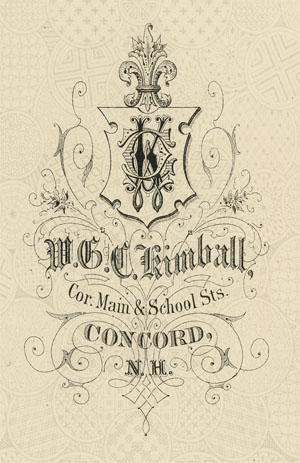
Printed logo on the back of a cabinet card.
From the late 1800s until 1966, photo albums were assembled for each school year at St. Paul’s School and made available for browsing in the library and the Rectory. These albums served a function similar to the colorful and glossy yearbooks we have today but in a format that reflected the photographic standards of their day. The majority of these albums were created using heavy cardboard pages bound on post bindings and had several photographs mounted on either side of each page. A few of the earliest albums in the archives collection are an exception to this standard and reflect the popularity of cabinet card photographs during the second half of the nineteenth century.
Cabinet cards are photographs mounted on a cardboard backing material, measuring a standard size of 4.25 X 6.5 inches (10.41 X 15.93 cm). The cards themselves have rounded corners and were often printed with elaborate photography studio logo designs on the back. They evolved as a larger version of the carte de visite, a highly popular small format photograph card that began being produced in the United States during the 1860s. Cabinet cards were exchanged among friends and were often stored in albums designed specifically to fit the cards. It is from a special album of this sort that this exhibit was created, featuring the cabinet card photographs of St. Paul’s School students from the 1860s through the 1880s.
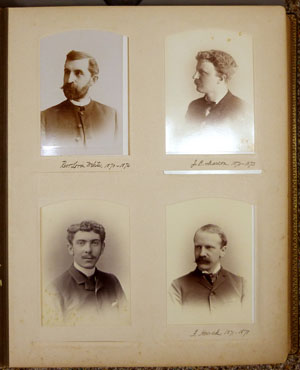
A page from the cabinet card album.
The album itself, embossed with the title “Library St. Paul’s School” in gold letters, contains 158 cabinet cards. Almost all of the photographs are identified in some way, with inscriptions either written on the cards themselves or on the pages in the album. There are several cabinet card portraits of students from the 1860s, although it is likely these photographs were taken some time after they graduated from the school. The majority of the card portraits are of students and faculty from the 1870s and 1880s, with a few later images of crew teams and student groups. Based on this information and the few cards in this collection that are dated, it is likely that these cabinet cards were collected beginning in the mid-1870s and continued to be added to during the 1880s, with the smallest number coming from the last few years of that decade.
Each of the 158 cabinet cards from this album has been researched, scanned, and made available online through the OLDA website (click HERE for the full list). The exhibit below features a selection of the cabinet card portraits and provides a glimpse into student life during the early decades of the School. Many of the entries include information about the lives led by these students after leaving Millville – the effect of their time here described best in one entry as: “. . . how the seed planted by St. Paul’s unknown to himself then, sprouted as he matured.”
Works consulted during research for this exhibit include cited issues of the Alumni Horae magazine and the following print titles:
Alumni Directory of St. Paul’s School. Concord, NH: Alumni Association of St. Paul’s School, 1956. Print.
Alumni Directory of St. Paul’s School. Concord, NH: Alumni Association of St. Paul’s School, 1996. Print.
Pier, Arthur Stanwood. St. Paul’s School 1855-1934. New York: Charles Scribner’s Sons, 1934. Print.(Ohrstrom: 373 Sa2)
Siegel, Elizabeth. Galleries of Friendship and Fame. New Haven: Yale University Press, 2010. Print. (Ohrstrom: 779 Si1G)
Exhibit Quick Links:
(See full exhibit below)
Click on the thumbnails above or the titles below to access the individual catalog pages.
Exhibit Entries:
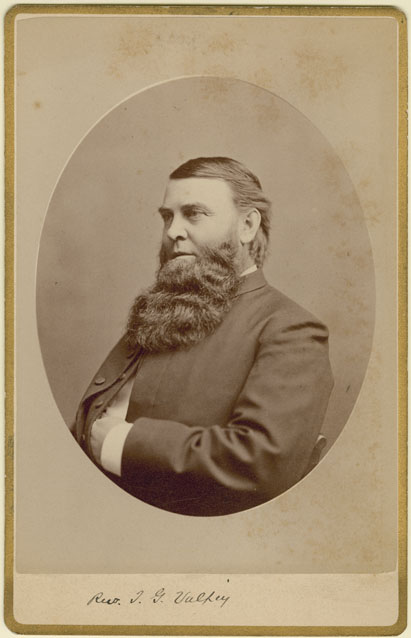
The Reverend Thomas Gilbert Valpey was a teacher of Greek at St. Paul’s School from 1860-1868, and then again from 1875-1890. Arthur Stanwood Pier’s St. Paul’s School 1855 -1934 (pg. 198) relates that Valpey gained a reputation among the students for being a thorough taskmaster. He would give his students only a few seconds to recite a Greek declension, timing them with his watch. He also had a habit of mumbling into his beard – described by Pier as “undoubtedly the most extensive beard that has ever been seen within the precincts of the school.”
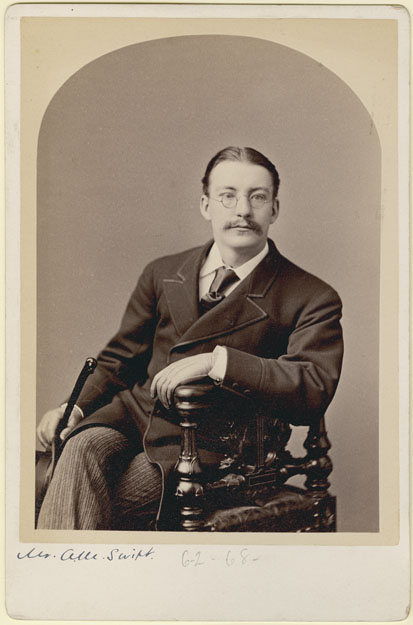
Augustus Muhlenberg Swift attended St. Paul’s School from 1862 to 1868 and is a member of the Form of 1867. From 1873 – 1883 Swift was a teacher at SPS, teaching History and English. His father, John Swift, was a Trustee of the School.
Pier’s St. Paul’s School 1855-1934 (pg. 109-112) describes his time at St. Paul’s School:
Bringing in an atmosphere of art, beauty, exquisiteness, not to say luxury and fashion, he was a pioneer in a school which hitherto had been accustomed to severe simplicity in all outward manifestations. . . He delighted to give dramatic recitations and to act. . . his temperament was that of the artist. . .
Unfortunately, Mr. Swift’s career at St. Paul’s was all too short. A severe illness compelled him to withdraw from the school in 1880 for the better part of a year. He was never in quite robust health afterwards. In 1884 he married and obtained a leave of absence for a year. He and his wife went to Italy for their honeymoon; in Rome he was stricken by a fever and died. The first organ in the New Chapel was given by his friends among the old boys of the school as a memorial to him. As lovable as he was talented, of priceless influence in mellowing and humanizing the spirit of St. Paul’s, dying when he was still a young man, he should be remembered as one who made a permanent contribution to the character and tone of the school.
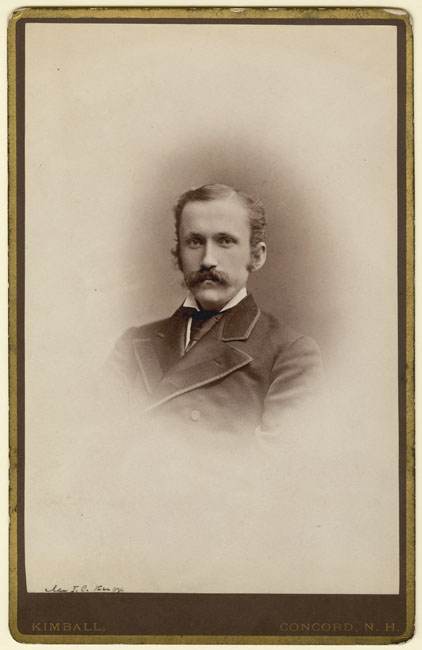
James Carter Knox attended St. Paul’s School from 1862 to 1867 and is a member of the Form of 1865. Knox went on to be a member of the faculty from 1868 – 1929, devoting over 60 years of his life in service to St. Paul’s School.
Arthur Stanwood Pier, in his book, St. Paul’s School 1855-1934 (pg. 103), described Mr. Knox this way:
Although English was the subject he taught, and taught well, he was capable at a moment’s notice of taking the most advanced classes in Latin or French. His chief work in the school was in music. During the half century that he was a member of the faculty, he was organist and choir master, and won the devoted affection of all the boys who worked under him in chapel. . . He had a charming tenor voice. Somewhat early in life he acquired an elderly manner and appearance – elderly yet still debonair.
Willard Scudder, in the obituary that appeared in the Spring 1930 Alumni Horae (pg. 23), had this to say about Knox’s time at St. Paul’s:
No other has given so long a service to St. Paul’s; no other has wrought a more noble work for St. Paul’s; no other has ended his task at an age so advanced.
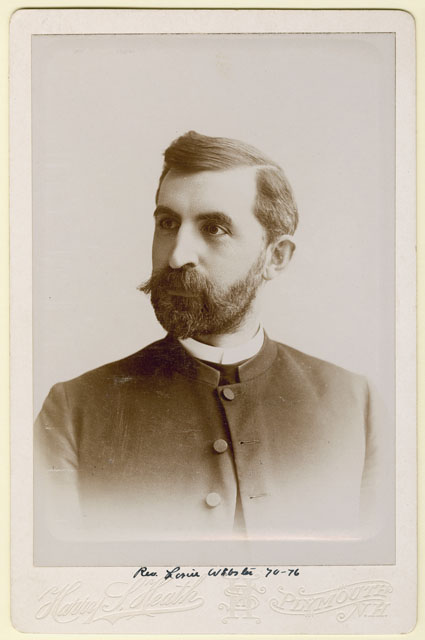
Lorin Webster attended St. Paul’s School from 1870 to 1876 and is a member of the Form of 1875.
His obituary, published in the Winter 1923 issue of the Alumni Horae (pg. 34), provides this information about Webster:
Lorin Webster will be remembered by the men of his day at St. Paul’s as an upright, manly boy, of strong physique, who studied well and was a good gymnast and oar, rowing on the first crew, Shattuck.
After graduating from Trinity College and being ordained to the ministry, he became an assistant Master at Holderness School and later Rector of the church at Ashland, N. H.; from which place he was called to be Rector of Holderness School. For thirty years he held this position, untiring in energy and ever alive to the best interest of the School, until he resigned to go to China.
He was serving as Professor of English at the College of the Rockefeller Foundation, in Peking, China, at the time of his death in 1923.
Webster’s name is recorded on one of the panels in the Chantry listing Alumni clergy of St. Paul’s School.
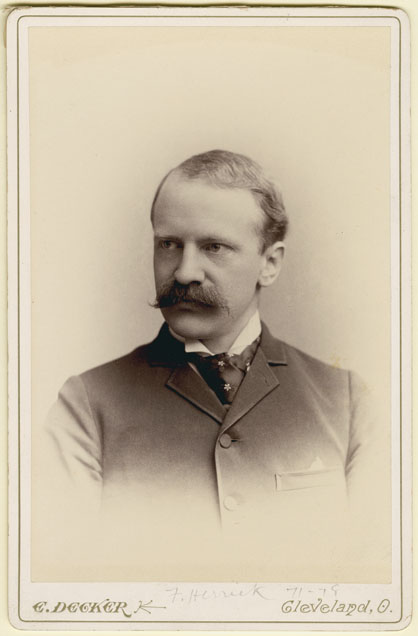
Francis Hobart Herrick attended St. Paul’s School from 1871 to 1878 and is a member of the Form of 1877.
Herrick was an author, ornithologist and biology professor. He wrote books on bird life, the American eagle, the American lobster, and a well-respected biography of John James Audubon.
The New England Aquarium website has this information about Herrick:
Francis Hobart Herrick, professor of biology in the Adelbert College of Western Reserve University (now Case Western Reserve University in Cleveland, Ohio), was asked in 1889 by the United States Commissioner of Fisheries to prepare a complete work on the general biology of the American Lobster. For five years Herrick researched lobsters along the coasts of Massachusetts, Maine, and New Hampshire from the United States Fish Commission laboratory at Woods Hole, Massachusetts. The culmination of his work was entitled The American Lobster: A study of its habits and development which he published in volume 15 of the Bulletin of the United States Fish Commission for 1895. This comprehensive study includes over 100 detailed and very accurate drawings of Homarus americanus.
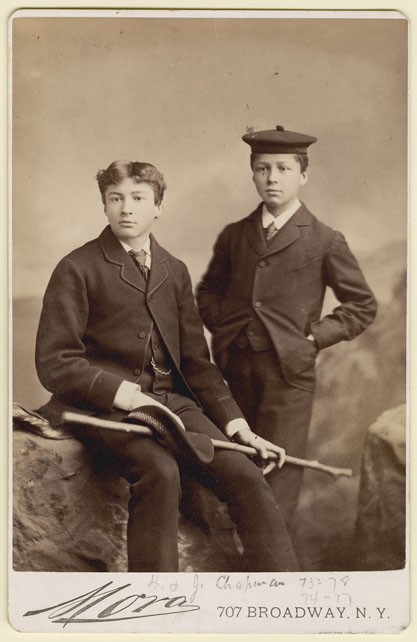
Henry Grafton Chapman (left) attended St. Paul’s School from 1873 to 1878 and is a member of the Form of 1878.
The 1917 School publication, The Fifth Form of 1878 (pg. 36), has this information about Chapman:
. . . born in New York on June 7, 1860, and graduated from Harvard in 1883; he was on the Freshman Crew which won the class race, and was also on the crew that defeated Columbia at New London in 1883; he was on the editorial board of the Harvard Advocate and the Harvard Lampoon, and wrote the Class Day Poem of 1883, which was highly commended; he studied at the Harvard Law School and was admitted to the bar in 1886, and practiced law in New York City; he did much literary work, and was a frequent contributor of articles; . . .
John Jay Chapman (right) attended St. Paul’s School from 1874 to 1877 and is a member of the Form of 1879.
John Jay Chapman was a celebrated writer. In his obituary published in the Winter 1933 edition of the Alumni Horae (pg. 98), writer Owen Wister, Form of 1877, had this to say about him:
St. Paul’s School has sent into the world of letters no writer so gifted as John Jay Chapman; more than this, he was the most gifted of his generation. To describe a quality which lies beyond the reach of description, we use the word genius, and it applies to him. His school life was so brief, and, to those who saw it, apparently so little involved in the general current, that one might well hesitate to ascribe what he became to anything imparted to him there, but for a certain essay which he wrote in later years. This, too, is among the significant examples of his complete mastery of words and the rare powers of intuition which his words conveyed; and it makes plain how much the School had to do with his spiritual growing up, how the seed planted by St. Paul’s unknown to himself then, sprouted as he matured. Spiritual is the word one thinks of first in thinking of him; intellectual is the second; artist, the third; and all upon a noble level.
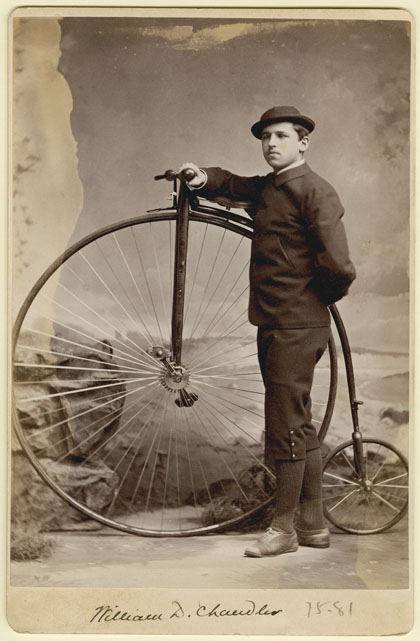
William Dwight Chandler attended St. Paul’s School from 1875 to 1881 and is a member of the Form of 1880.
The Winter 1926 edition of the Alumni Horae (pg. 94) contains this information about Chandler:
Willie Chandler was at St. Paul’s from 1875 to 1881 and he will be affectionately remembered for his many attractive qualities, but particularly for his unfailing good humor and for his lively interest in all forms of School activities. He was a fine football player and in his last year was Captain of the School Football Team. Being of a robust physique he was a good oar and rowed on the Shattuck Crews and he retained his interest in the boat races all his life. After leaving the School he traveled abroad for two years, returning to Concord where he became the publisher of the Concord Monitor. He was always active in Republican politics in New Hampshire. At the time of his death he was Postmaster at Concord, and it was largely due to his interest that the Post Office at St. Paul’s School was installed. . . During all the years of his residence in Concord he was an influential and loyal supporter of St. Paul’s and the School is indebted to him for very many acts of consideration and kindness, not only during the time of his Postmastership but during the period when he was publisher of the Concord Monitor.
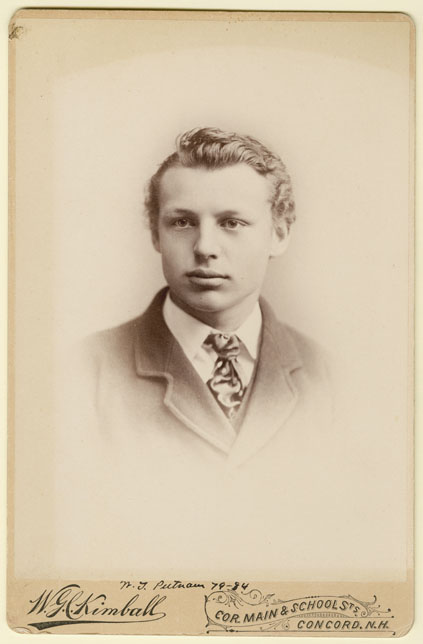
William Throckmorton Putnam attended St. Paul’s School from 1878 to 1884 and is a member of the Form of 1883.
The Autumn 1957 Alumni Horae (pg. 158) obituary provides this information about Putnam:
He was born in Jersey City, New Jersey, the son of the Reverend Fernando C. Putnam and Ada Ann Putnam, and entered St. Paul’s in 1878. He was Treasurer of the Missionary Society, played football (a new sport at the School in those days), and was one of the best runners in the hare-and-hounds. He remained through the then post-graduate Sixth Form year, entered Trinity College, Hartford, Connecticut, in 1884, and received his degree there in 1888. For the next thirty-five years he lived at Lake Cushman, Oregon, where he operated the first summer resort in the State of Washington, and was appointed postmaster by President Cleveland. . . His affectionate interest in St. Paul’s School continued all his life.
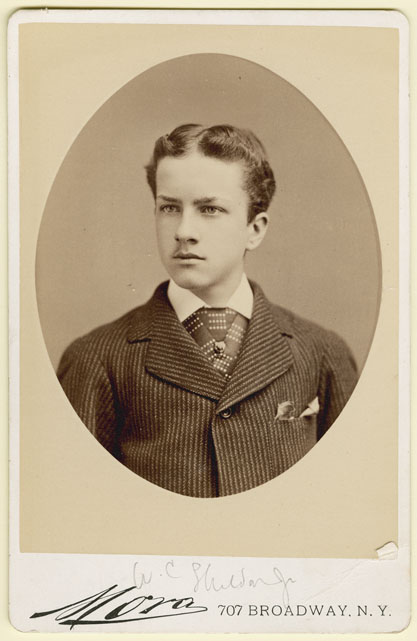
William Crawford Sheldon attended St. Paul’s School from 1872 to 1878 and is a member of the Form of 1878.
The Spring 1928 Alumni Horae (pg. 28-29) obituary for Sheldon describes him as:
. . . a man who had a talent for friendship. Not many men have been beloved as he was by those who knew him. He, in turn, was steadfast to his friends and never failed one when in need. St. Paul’s can number few more devoted sons. His heart was wrapped in St. Paul’s memories. Shortly before he died, when he was ill and suffering, against the advice of his doctor he insisted on visiting the school and returned home full of enthusiasm over the improvements and additions which he had observed. As he grew older his affection for the School seemed to increase. He ever took a keen interest in its welfare. . .
In the year 1900 the Sheldon Library was given to St. Paul’s School as a memorial to William C. Sheldon by his four children, George R. Sheldon, William C. Sheldon, Mrs. W. S. P. Prentice and Mrs. Alfred C. Harrison. The Sedilia in the Chapel were also given in 1897 by the Sheldon family in memory of the father.
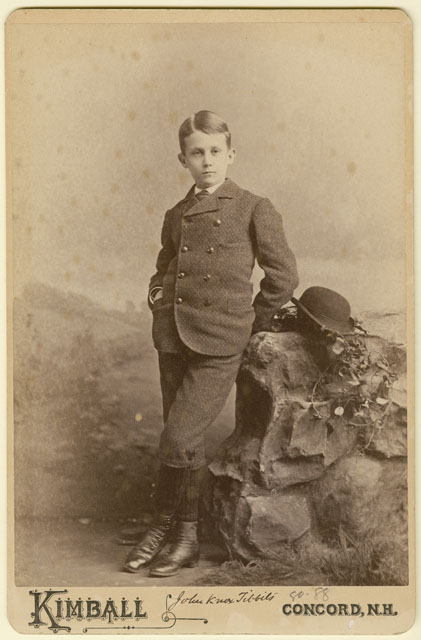
John Knox Tibbits attended St. Paul’s School from 1880 to 1888 and is a member of the Form of 1887. He taught Latin at St. Paul’s School from 1894-1910.
The Spring 1956 Alumni Horae (pg. 59) obituary provides this information about Tibbits:
His mother having died when he was a child, he entered St. Paul’s at the age of nine; for his father felt that his uncles, Charles and James Knox, masters at the School, would look out for him. He remained in the School eight years, distinguished himself – although frail and light – as a player of cricket, racquets, and tennis. He was a charter member of the Cadmean, and he and M. K. Gordon, his close friend for seventy-five years, were Associate Head Editors of the Horae. He was awarded the School Medal in 1887. After graduating from Yale in 1892, he studied for the ministry, first at Yale, and afterwards at Exeter College, Oxford, where he received the degree of A.M. He returned to the School as a master (without salary) in 1894, lived in the Lower School and taught Latin – and also, that first year, introduced golf to the School; laid out the course himself and paid all the costs for several years. He was ordained deacon in 1897, and priest a year later. Shortly thereafter, though he remained a master, he was named priest-in-charge at St. Timothy’s Church. His chief work was among the stone-cutters and quarry-men in North Concord. He built a chapel there, and worked among them for years. In 1910, he married Marguerite Vinton Harris, resigned his mastership, and built the house on the road to Concord (now Winant House) which he afterwards sold to Governor Winant. . . John Knox Tibbits gave much to St. Paul’s School and to the parishes he served in Concord and elsewhere. He was a very intelligent man, whose outstanding qualities were humility and unselfishness.
John Knox Tibbits’ name is recorded on one of the panels in the Chantry listing Alumni clergy of St. Paul’s School.
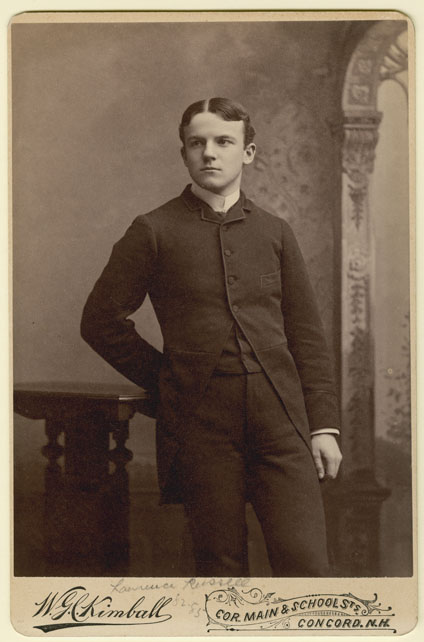
Lawrence Russell attended St. Paul’s School from 1882 to 1885 and is a member of the Form of 1885.
The Spring 1938 Alumni Horae (pg. 56) obituary provides this information about Russell:
One of a long line of lawyers and judges, Mr. Russell practised law in Canton, N. Y. for almost 45 years. He was born in Malden, Mass, on July 27, 1867 and attended Williams previous to the study of law at Columbia. For a time he practised law in his father’s office in New York City before making his permanent home in Canton. On the maternal side, he was a descendant of that Lieutenant James Lawrence who in the battle of Lake Erie in the War of 1812 voiced the historic slogan, “Don’t give up the ship.”
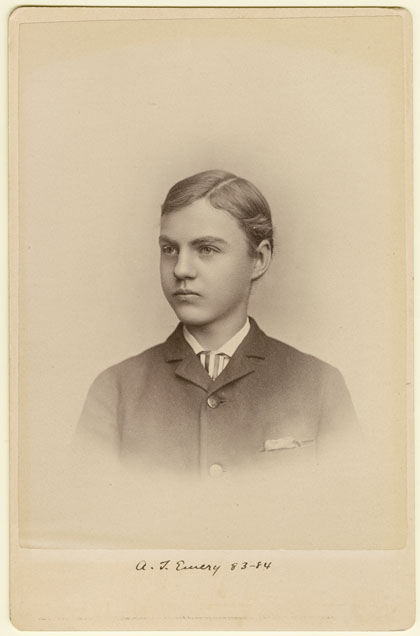
Albert Thomas Emery attended St. Paul’s School from 1883 to 1884 and is a member of the Form of 1885.
According to Arthur Stanwood Pier’s book, St. Paul’s School 1855-1934 (pg. 134), Emery died while a student at St. Paul’s School as the result of a sledding accident:
… some boys found the Shute’s Hill coast, as it was called, too tame; they dragged their sleds to the top of Tibbits hill – Fiske hill, to give it its modern name – and came flying down to the Concord road. Augustus M. Swift as a boy coasted from the top of Fiske hill to the old grist mill on the site of which Hargate Hall now stands; and a few years later Richard H. Dana equaled his record. Possibly in time it might have been broken, had not a tragic occurrence put an end to all such breath-taking trips. In February, 1884, Albert Emery of the Third Form ran head on at great speed into a sled that another boy was pulling up the hill. He was fatally injured and died nine days after the accident. Since that time coasting on Fiske hill has been forbidden.
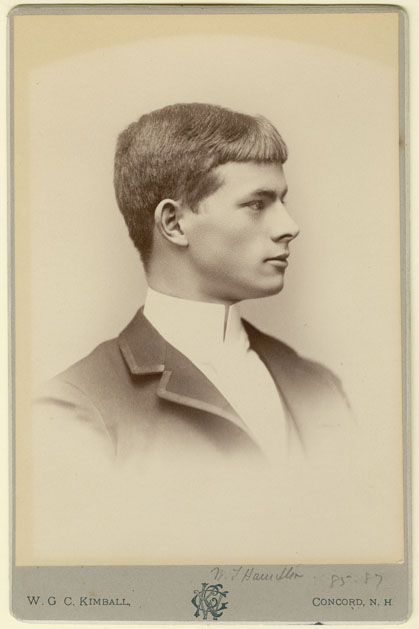
William Thomas Hamilton Jr. attended St. Paul’s School from 1885 to 1887 and is a member of the Form of 1888.
The Spring 1950 Alumni Horae (pg. 33) obituary provides this information about Hamilton:
After three years at St. Paul’s, he entered St. John’s College, Annapolis, Md. He then pursued his law studies at the University of Munich at the conclusion of which he was admitted to the bar. Mr. Hamilton was the son of the late Governor William Thomas Hamilton and from him inherited great civic and community pride. He served for nine years as president of the board of the Washington County Free Library of Hagerstown; he was a charter member of the board of trustees of the Washington County Museum of Fine Arts and served as secretary of the group for ten years; and he was an active member of the Hagerstown Park Commission and worked tirelessly in enhancing the natural beauty of the City Park.
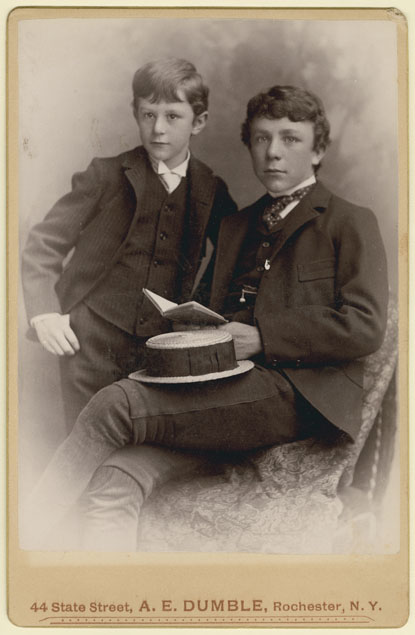
Frank Hawley Ward (left) attended St. Paul’s School from 1889 to 1893 and is a member of the Form of 1892.
The Summer 1958 Alumni Horae (pg. 116) obituary provides this information about Frank H. Ward:
Born in Rochester, he entered St. Paul’s in 1889, won the Ferguson Scholarship there as a Fourth Former, and graduated in 1892, after which he returned for the post-graduate Sixth Form year. He graduated from Princeton in 1896, did graduate study there in electricity, and in about 1900 went to work in the General Electric Company’s testing laboratory in Schenectady, New York. A year later he went to Canada as a supervisor of electrical installations; he also worked for a year with a power company in Georgia. On his return to Rochester in 1905, he was appointed New York State zoologist. In 1910, he began work in Ward’s Natural Science Establishment, of which his father was then president. After his father’s death in 1927, he himself directed the Establishment until 1931, since when he had been chairman of the board.
William Douglas Ward (right) attended St. Paul’s School from 1886 to 1892 and is a member of the Form of 1891. According to The class of 1895, Princeton University, decennial record, 1895-1905 (pg. 391-394), William Douglas “Dougal” Ward graduated from Princeton in 1895 and was a star football player during his time there. He spent the year after graduation teaching mathematics and coaching football at Lawrenceville, and then went on to medical school at the University of Michigan. He also coached football at Michigan while pursuing his studies. He finished his medical degree at the University of Pennsylvania and became a surgeon in Rochester, NY.
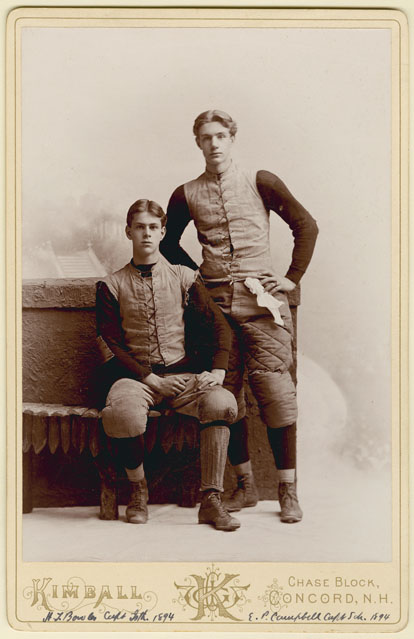
This photograph shows two students dressed in football uniforms and identifies them as:
Henry Thornton Bowles (left), Captain of the Isthmian football team – who attended St. Paul’s School from 1892 to 1895 and is a member of the Form of 1894.
Edwin Prall Campbell (right), Captain of the School football team – who attended St. Paul’s School from 1889 to 1895 and is a member of the Form of 1894. The Autumn 1949 edition of the Alumni Horae (pg. 118) contains this information about Campbell:
He attended the School from 1889 to 1895 and was graduated from the Sheffield Scientific School of Yale in 1898. For many years he was a member of the New York Stock Exchange and of the stock exchange firm of H. G. Campbell & Co. Since 1941 he had lived at Marlow, N. H., where he devoted his time to his home and garden. He was a member of the Society of Colonial Wars, the Huguenot Society of America, and the St. Nicholas Society. He was a brother of Henry Godwin Campbell, ’92, of Brookfield, Conn.
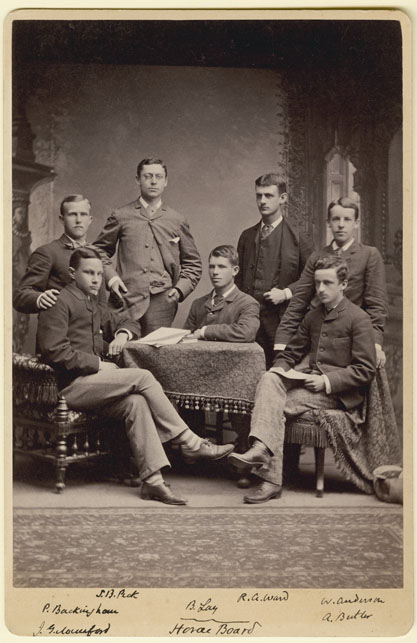
The photograph features students identified as members of the Horae Board from 1881:
Standing (left to right):
P. Buckingham: Percy Manville Buckingham attended St. Paul’s School from 1878 to 1882 and is a member of the Form of 1882.
S. B. Peck: Staunton Bloodgood Peck attended St. Paul’s School from 1878 to 1882 and is a member of the Form of 1881. The Autumn 1950 issue of the Alumni Horae (pg. 129) included this information about Peck:
Staunton Bloodgood Peck, inventor and retired vice-president and director of the Link Belt Company, Philadelphia, was connected with this company during his entire business and professional career.
R. A. Ward: Rodney Allen Ward attended St. Paul’s School from 1880 to 1882 and is a member of the Form of 1881. The Winter 1925 issue of the Alumni Horae (pg. 110) included this information about Ward:
He was only at St. Paul’s School for two years, but endeared himself to the members of his Form by his amiable personality and by his fine sense of duty and faithfulness. He was a hard and conscientious student. Ward did not go to college after leaving St. Paul’s, but traveled abroad.
W. Anderson: William Burrall Anderson attended St. Paul’s School from 1879 to 1882 and is a member of the Form of 1882.
Sitting (left to right):
J. G. Mumford: James Gregory Mumford attended St. Paul’s School from 1878 to 1881 and is a member of the Form of 1880.
B. Lay: Beirne Lay attended St. Paul’s School from 1877 to 1881 and is a member of the Form of 1879. He was a member of the faculty from 1894 to 1929. The Summer 1954 edition of the Alumni Horae (pg. 113) contains this information about Lay:
At school Lay was a good student and was prominent in various activities, especially in rowing. Entering Yale in the sophomore year, he rowed on his class crew, was a member of Psi Upsilon and Elihu Club. He was also active in football, being a friend of Walter Camp, who at the time was developing the American game. . . After leaving Yale, he studied law at the Columbia Law School for one year, and worked in a law office in Erie, Pa., and then in the office of Harrison and Bond in Baltimore. . . His law practice was interrupted early in 1895, when he returned to St. Paul’s, intending to stay for one year to help out as a master after the death of the first Rector. He remained for thirty-five years. During his years at the School, his work was chiefly in the Mathematics Department . . .
A. Butler: Allan Macy Butler attended St. Paul’s School from 1879 to 1881 and is a member of the Form of 1880.
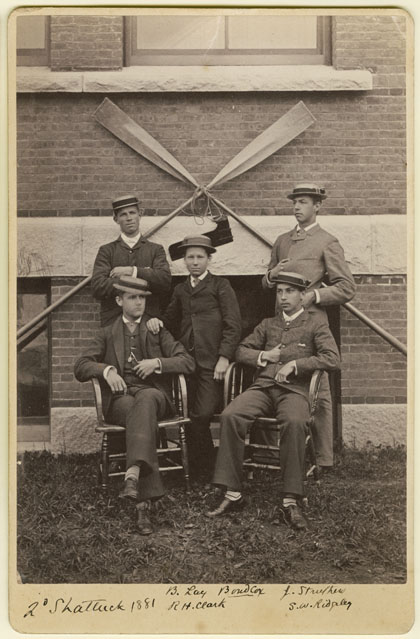
The photograph features students identified as members of the second Shattuck crew of 1881:
Standing (left to right):
B. Lay: Beirne Lay attended St. Paul’s School from 1877 to 1881 and is a member of the Form of 1879. He was a member of the faculty from 1894 to 1929. The Summer 1954 edition of the Alumni Horae (pg. 113) contains this information about Lay:
At school Lay was a good student and was prominent in various activities, especially in rowing. Entering Yale in the sophomore year, he rowed on his class crew, was a member of Psi Upsilon and Elihu Club. He was also active in football, being a friend of Walter Camp, who at the time was developing the American game. . . After leaving Yale, he studied law at the Columbia Law School for one year, and worked in a law office in Erie, Pa., and then in the office of Harrison and Bond in Baltimore. . . His law practice was interrupted early in 1895, when he returned to St. Paul’s, intending to stay for one year to help out as a master after the death of the first Rector. He remained for thirty-five years. During his years at the School, his work was chiefly in the Mathematics Department . . .
Bond: Either Marshall Latham Bond who attended St. Paul’s School from 1880 to 1883 and is a member of the Form of 1884 or Louis Whitford Bond who attended St. Paul’s School from 1880 to 1883 and is a member of the Form of 1883.
J. Struthers: James Struthers attended St. Paul’s School from 1878 to 1882 and is a member of the Form of 1882.
Sitting (left to right):
R. H. Clark: Robert Henry Clark attended St. Paul’s School from 1879 to 1883 and is a member of the Form of 1881. He was also a member of the faculty from 1884 to 1886.
S. W. Ridgeley: Samuel Wiggins Ridgeley attended St. Paul’s School from 1880 to 1883 and is a member of the Form of 1882.
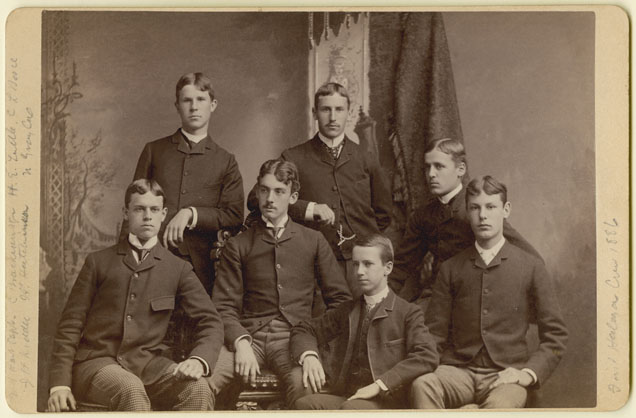
The photograph features members of the first Halcyon crew team of 1886:
W. H. Hart: William Howard Hart attended St. Paul’s School from 1880 to 1886 and is a member of the Form of 1886. The Spring 1959 edition of the Alumni Horae (pg. 43) contains this information about Hart:
He entered St. Paul’s in 1880, was captain and stroke of the Halcyon crew in his last year there, and graduated in 1886. He graduated from the University of Pennsylvania in 1890, afterwards read law, and was admitted to practice in 1897. . . He was a member of the First Troop Philadelphia City Cavalry and served with the Troop in the Spanish-American War.
C. Brackenridge: Charles David Brackenridge attended St. Paul’s School from 1882 to 1887 and is a member of the Form of 1886.
H. E. Tuttle: Herbert Edward Tuttle attended St. Paul’s School from 1885 to 1887 and is a member of the Form of 1886.
C. L. Borie: Charles Louis Borie Jr. attended St. Paul’s School from 1884 to 1888 and is a member of the Form of 1888. The Autumn 1943 edition of the Alumni Horae (pg. 128) contains this information about Borie:
In 1902 he became associated with Clarence Clark Zantzinger, ’88, as Zantzinger & Borie, architects. He was one of the designers of Philadelphia’s Benjamin Franklin Parkway and he selected the site and aided in the design of the Philadelphia Art Museum at the head of the parkway. Other buildings in which he assisted in the architectural work are the Sheffield Scientific School at Yale, the administration building of the University of Chicago, and the Department of Justice building in Washington.
J. H. Kidder: James Hathaway Kidder attended St. Paul’s School from 1885 to 1888 and is a member of the Form of 1888. The Spring 1957 edition of the Alumni Horae (pg. 52) contains this information about Kidder:
He was a graduate of Harvard, Class of 1892. In the first World War, he was a Captain in the Army. At the School he was captain of the Halcyon crew.
J. P. Hutchinson: James Pemberton Hutchinson attended St. Paul’s School from 1882 to 1886 and is a member of the Form of 1885. The Autumn 1943 edition of the Alumni Horae (pg. 126-127) contains this information about Hutchinson:
Dr. James Pemberton Hutchinson, prominent Philadelphia surgeon, distinguished himself during World War I as head of the American Hospital in France. He sailed for Europe in 1915 as a member of the University of Pennsylvania unit of the American Hospital. In 1917, after the United States entered the war, he was commissioned a major and placed in charge of the American Hospital at Neuilly, France. For his service he was awarded the Distinguished Service Medal and was given the Cross of the Legion of Honor by the French Government. After his graduation from Harvard and from the University of Pennsylvania Medical School, Dr. Hutchinson served his internship at Pennsylvania Hospital, and, at the time he went overseas, he was on the staff of several of his city’s hospitals. After the war he became medical director of the Penn Mutual Life Insurance Co.
N. Gray: Niel Gray attended St. Paul’s School from 1883 to 1887 and is a member of the Form of 1886. The Spring 1938 edition of the Alumni Horae (pg. 56) contains this information about Gray:
He was formerly the owner of the Oswego (N. Y.) Machine Works which manufactured paper cutting machines. During the World War he was a member of the War Industries Board. After his retirement, he lived in Philadelphia but spent much of his time in travel. He was always very responsive to calls from S. P. S. and in 1936, as chairman of his Fiftieth Reunion, brought back a large crowd of his form-mates at Anniversary.



